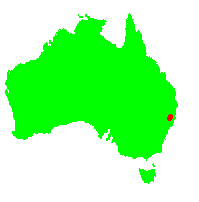General Description:
Macrozamias are part of a very ancient group of plants known as cycads. The genus Macrozamia is endemic to Australia and there are about 25 species. They do not produce flowers and reproduce by means of cones borne on separate male and female plants. All species have dark green, palm-like fronds arising from a central trunk. In some species the trunk is very short or subterranean.
Macrozamia fawcettii is a small cycad with several leaves arising from an underground trunk. The leaves are 500 – 1500 mm long with glossy green, linear-shaped leaflets 50 – 300 mm long. Cones appear irregularly, perhaps at intervals of 3 to 5 years. The male cones are green, cylindrical in shape (150-250 mm long by 50-60 mm wide, aging to a greyish-brown colour. Female cones are also green, cylindrical or barrel shaped to about 300 mm x 150 mm. When ripe, the cone on the female plant breaks apart to release the large, bright red seeds which are about 30mm long by 20mm wide.
As with all cycads, the seeds of M.fawcettii contain compounds which are highly toxic. Seeds of some species have caused fatalities to both humans and livestock. Despite this, Aborigines developed a method of vigorous leaching to remove the toxins and most species of Macrozamia were an important part of their diet.
M.fawcettii has received only limited cultivation but would form a very attractive plant for a garden or container. As with most cycads, the plant is very slow growing and may take 5 years or more to be noticed as a feature plant and many more years to reach anything like a reasonable size. Cones should not be expected for 10 years or more. M.fawcettii is not demanding in its requirements but is best grown in a protected position in moist, well drained soils.
Propagation is from seed which germinates easily without the need for any pretreatment.
For further information on cycads and their cultivation see:
- Cycads of the World (2000); David L. Jones, Reed New Holland, Australia.
- The Cycad Pages
- Cultivation of Australian Cycads

Male cones on Macrozamia fawcettii
Photo: Allan Harris
 Australian Native Plants Society (Australia)
Australian Native Plants Society (Australia)